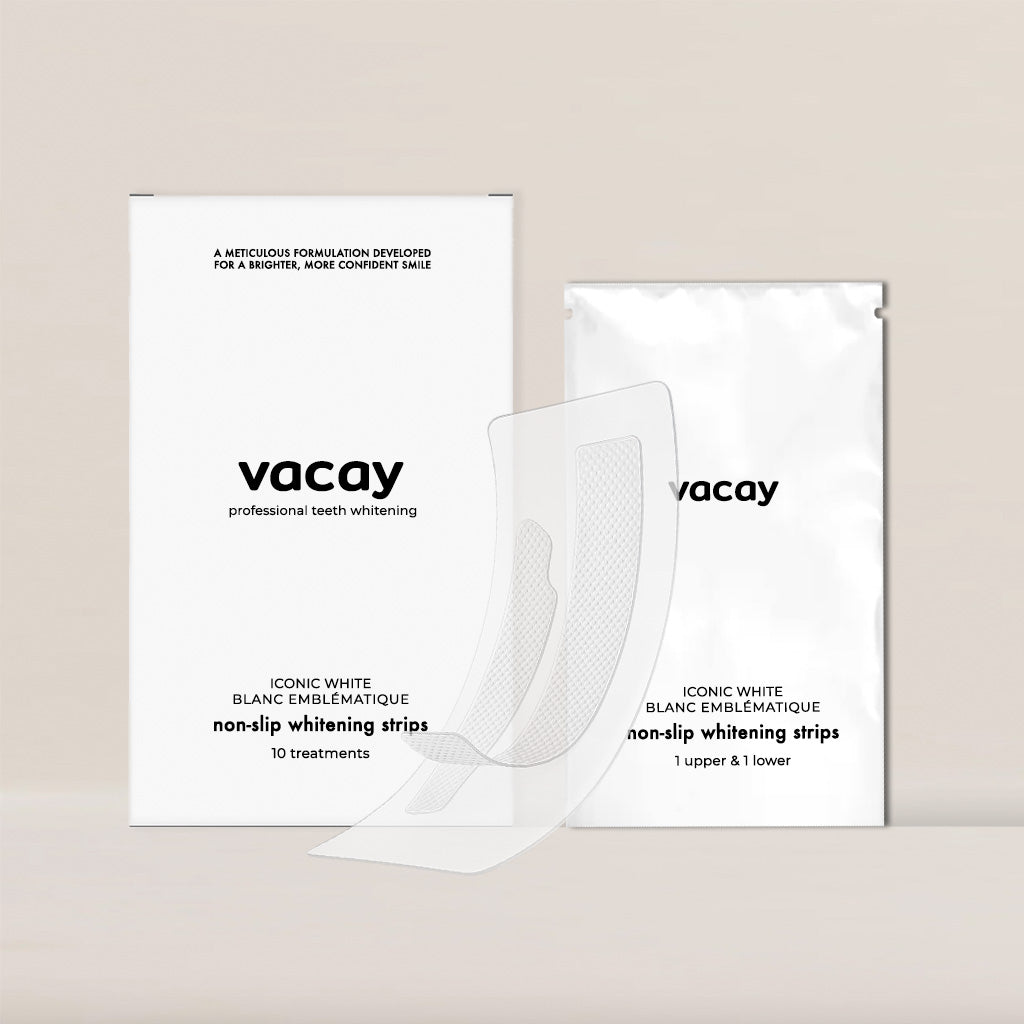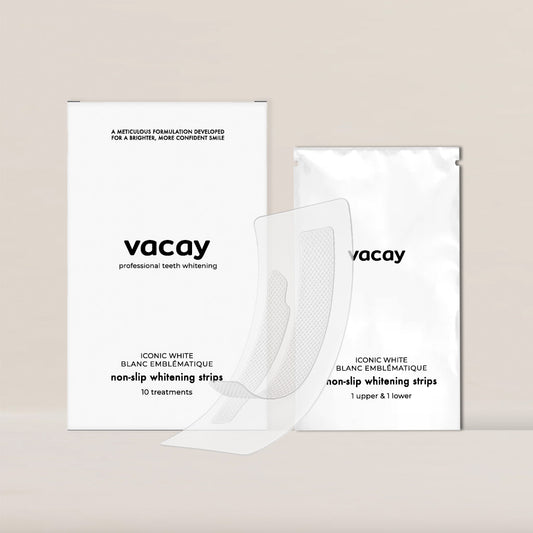
Can You Eat After White Strips? Do THIS After Teeth Whitening
We all want that freshly-whitened, just-back-from-the-dentist glow—but without the actual dental appointment. Whitening strips are one of the most popular at-home ways to achieve a brighter smile, and they really can deliver. Crest 3D Whitening Strips are particularly effective and a popular choice for at-home teeth whitening. But if you’ve ever found yourself standing in your kitchen afterward wondering, Can I eat now?—you’re not alone.
Here’s everything you need to know about what to do after using whitening strips, including what to eat, what to skip, and how to keep your teeth sparkling longer.
First, Let’s Talk About How Whitening Strips Work
Whitening strips use a light bleaching agent—usually hydrogen peroxide—that gently lifts stains from your enamel. Most whitening strips utilize active ingredients like hydrogen peroxide to effectively penetrate the teeth and break down stains. Think of them as a mini facial for your teeth: they work by breaking down the molecules causing discoloration, revealing a whiter, brighter layer underneath.
✨ Pro Tip: Brush your teeth before applying whitening strips. This helps remove plaque and gives the strips better contact with your enamel. But skip brushing right after if your teeth feel sensitive—give them time to rest.
Teeth Whitening with Whitening Strips
Teeth whitening with whitening strips is a popular and effective way to achieve a brighter smile. These thin, flexible strips are coated with a peroxide-based gel that targets surface stains and discoloration. The active ingredients, usually hydrogen peroxide or carbamide peroxide, work by breaking down the stains and whitening your teeth.
Using whitening strips is straightforward. Simply peel off the backing and apply the strip to your teeth, ensuring it adheres well. Follow the manufacturer’s instructions for the duration—typically anywhere from 30 minutes to a few hours. After the treatment, remove the strips and rinse your teeth with water.
Whitening strips offer a convenient, non-invasive method to whiten teeth at home. Just remember to follow the instructions carefully to achieve the best results and avoid any potential issues.
So, Can You Eat After Whitening Strips?
Short answer: yes, but there’s a catch.
-
Wait at least 30 minutes before eating or drinking anything. This gives the whitening gel time to settle into the enamel.
-
Avoid anything that can stain your teeth for the next two hours—think coffee, wine, or your go-to pasta with red sauce.
-
Drink water—it’s safe, gentle, and helps rinse away any leftover gel.
-
Stick to lighter foods if you’re eating soon after: plain rice, chicken, cauliflower, peeled apples, or pasta with olive oil are great post-strip options.
Eating After Whitening Strips: What to Avoid and What’s Safe
After using whitening strips, it’s crucial to be mindful of your food and drink choices to maintain your newly brightened smile. Certain foods and drinks can stain teeth, while others are safe to consume.
What to Avoid Right After Whitening
The post-strip phase is like a fresh manicure—you don’t want to mess it up right away. For the first 24 hours:
It's crucial to protect your newly whitened teeth by avoiding certain foods and practices that could stain or damage the whiteness achieved by the whitening treatment.
Avoid:
-
Coffee and tea (yes, sadly—even iced)
-
Red wine
-
Tomato-based sauces
-
Berries and pomegranates
-
Soda and citrus juices
-
Soy sauce and balsamic vinegar
These foods are super pigmented or acidic, which makes them more likely to stain freshly whitened teeth or trigger sensitivity. Individuals with sensitive teeth should be particularly cautious and may want to choose products specifically designed for sensitivity to avoid discomfort during the whitening process.
How to Maintain Your Bright New Smile
A whiter smile isn’t just about the strips—it’s what you do after that makes the biggest difference. Think of this as your post-glow maintenance plan:
-
🪥 Brush twice a day (a soft-bristled brush is your friend).
-
🦷 Floss daily—it removes the in-between stuff your brush can’t.
-
🧴 Use a whitening toothpaste with gentle abrasives to help polish away surface stains. Teeth whitening products like Crest 3D Whitening Strips are effective, but following specific aftercare guidelines is crucial to maintain the whitening results.
-
🚭 Avoid smoking and dark drinks when you can. At-home teeth whitening products are convenient and effective, but regular oral hygiene practices are essential to maintain the results.
-
🪩 Visit your dentist regularly to keep your enamel strong and your color even.
Tips for a Brighter Smile
To keep your smile bright and radiant, follow these tips:
-
Brush Regularly: Use a whitening toothpaste to remove surface stains and prevent new ones from forming.
-
Floss Daily: This helps remove plaque and food particles from between your teeth.
-
Avoid Smoking: Tobacco products can stain teeth and cause other oral health issues.
-
Limit Stain-Causing Foods and Drinks: Be mindful of what you consume to avoid discoloration.
-
Use a Straw: When drinking coffee or tea, use a straw to minimize contact with your teeth.
-
Whitening Mouthwash: Regularly clean your teeth with a whitening mouthwash to maintain their whiteness.
By incorporating these tips into your daily routine, you can enjoy the benefits of teeth whitening for a longer period.
Whitening Toothpaste = Your New BFF
If whitening strips are your short-term glow-up, whitening toothpaste is your long-term maintenance plan. Look for a formula that includes:
-
Gentle abrasives to buff away stains
-
Hydrogen peroxide or carbamide peroxide
-
Fluoride to keep enamel strong
Whitening toothpastes contain specific ingredients that aid in removing surface stains and provide additional tips for preventing staining through regular oral hygiene practices.
Use it once or twice a day depending on the formula (read the label!) and you’ll stretch out those results way longer.
The Best Way to Use Whitening Strips (Without Damaging Your tooth enamel)
-
Brush your teeth first, then wait 30 minutes before applying the strips.
-
Apply to dry teeth (yes, wipe them off first).
-
Follow the time instructions—longer isn’t better here. Proper care after using teeth whitening strips is crucial, particularly regarding dietary choices to maintain a bright smile.
-
If your teeth feel extra sensitive, try every other day instead of daily. Following specific guidelines for the use of tooth whitening strips, such as avoiding certain foods that can stain teeth immediately after application, is essential to achieve optimal results.
Remember: more isn’t always more when it comes to whitening. Be consistent, but gentle.
Considering Professional Whitening?
If you’re prepping for a wedding, a big photo shoot, or just want a dramatic transformation, in-office teeth whitening treatment or dentist-made custom trays might be worth it. These treatments are stronger, faster, and more tailored to your tooth enamel needs. The downside? Tooth sensitivity. They’re also more expensive—and yes, they can hurt like hell. But the results? Chef’s kiss.
If you’ve got 10 days before your event, Vacay Whitening Strips can help you achieve that same veneer-like look, we use the same professional teeth whitening ingredients. It just takes a little longer—and they’re way more friendly on your teeth.
TL;DR
Yes, you can eat after whitening strips—just wait at least 30 minutes and be mindful of what you eat for the next 24 hours. Skip coffee, wine, and anything acidic or deeply pigmented, and opt for light, gentle foods instead. Keep brushing, flossing, and use a whitening toothpaste to keep that glow going.
The process and safety of whitening teeth are crucial, emphasizing the importance of using effective products and understanding personal whitening goals.
Because let’s be real: a confident, radiant smile? That’s always in style.




